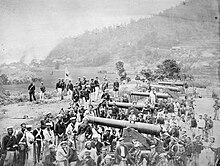Genji
Appearance
Genji (元治) was a Japanese era name (年号,, nengō,, lit. "year name") after Bunkyū and before Keiō. This period spanned only slightly more than a single year from February 1864 through April 1865.[1] The reigning emperor was Kōmei-tennō (孝明天皇).[2]
The nengō Genji means "original rule".[3]
Events of the Genji era
[change | change source]
.
- 8 July 1864 (Genji 1, 5th day of the 6th month): Skirmish at Ikedaya near Kyoto, also known as Ikedaya Jiken or Ikedaya Incident. Samurai supporting the emperor clashed with police forces of the Tokugawa shogunate.[4]
- 12 August 1864 (Genji 1, 11th day of the 7th month): Sakuma Shōzan is assassinated at age 53.[5] Anti-shogunate (sonno joi) forces were responsible for his death.[6]
- 5-6 September 1864 (Genji 1, 5th-6th day of the 8th month): Bombardment of Shimonoseki[7]
Related pages
[change | change source]References
[change | change source]- ↑ Nussbaum, Louis-Frédéric. (2002). "Genji" in Japan Encyclopedia, p. 236.
- ↑ Nussbaum, "Kōmei Tennō," p. 553.
- ↑ Griffis, William Elliot. (1915). The Mikado: Institution and Person, p. 84.
- ↑ Nussbaum, "Ikedaya Jiken" at p. 378.
- ↑ Armstrong, Robert Cornell. (1914). Light from the East or Studies in Japanese Confucianism, p. 192; Nussbaum, "Sakuma Shōzan" at pp. 813-814.
- ↑ National Diet Library: Portraits of Modern Japanese Historical Figures.
- ↑ Nussbaum, "Shimonoseki" at p. 862.
Other websites
[change | change source]- National Diet Library, "The Japanese Calendar" -- historical overview plus illustrative images from library's collection
| Genji | 1st | 2nd |
|---|---|---|
| 1864 | 1865 |
| Preceded by: Bunkyū |
Era or nengō: Genji |
Succeeded by: Keiō |
